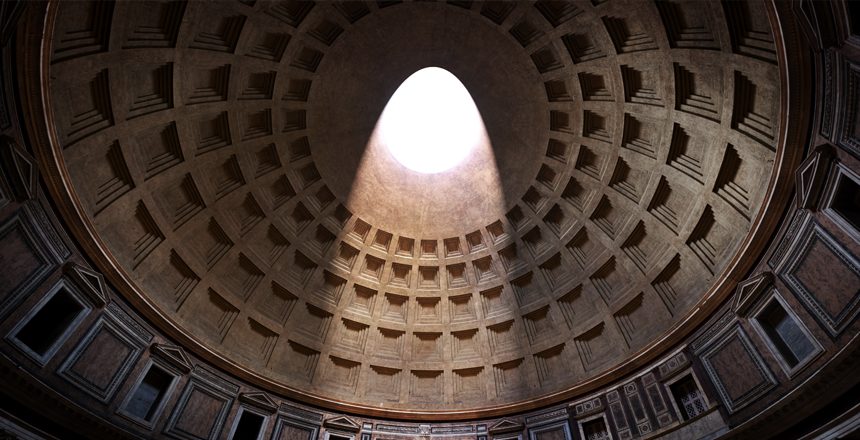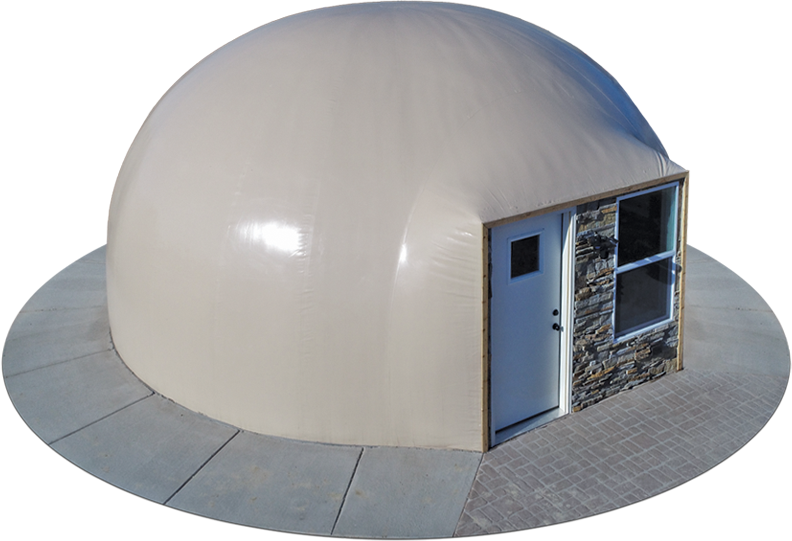The word “dome” originates from the Greek and Latin “Domes Dei” which means “House of God.” Throughout history, domes have been associated with sacred or heavenly symbolism.
Domes have also been called the “king of all roofs” as they have no angles or curves and do not require a single column to reinforce them. Yet, they are still one of the strongest and most durable structures in existence. Let’s look at the role domes and concrete dome architecture play throughout history.
The Dome Origin Story
Dome construction dates back to prehistoric times. The earliest discovered dome home was found in Ukraine and dated back to 19,000 B.C. Little is known about the prehistoric era, but the dome home may have been the first version of a man-made home.
After the prehistoric period, the earliest form of the modern dome was found within the Inuit group of Indigenous people in the Arctic and Subarctic regions of Alaska, Greenland, and Canada. These people built igloos, also known as snow huts or snow homes. Igloos are made of compressed snow, are strong, and provide excellent insulation.
Concrete Dome Architecture in Rome
Most ancient buildings were rectangular and required the reinforcement of columns to support the heavy roof. By 100 A.D., architects began to experiment with new techniques. Roman architects discovered that when they rotated an arch 360º, it created a three-dimensional solid shape. This was revolutionary for the Romans, who had previously used columns to hold up the roofs of their buildings.
As time moved on, architects improved concrete dome architecture to withstand both height and weight difficulties. And the dome continues to be a popular architectural element to this day.
Why Domes Still Exist
Domes continue to appear in modern architecture throughout the world. They are one of the only architectural elements that have appeared in prehistoric, Persian, Hellenistic, Roman, Chinese, and Indigenous cultures because of the following reasons:
Materials
A dome can be made from a variety of easily-accessible materials. Igloos were made from compressed snow, domes in the Middle East were made from mud-brick and stone, Roman domes were made from a mixture of stone and mortar, and today they are made from concrete and steel rebar.
Strength
Materials used in ancient dome construction were not necessarily strong—though modern materials are, their geometry provides the strength of concrete dome architecture. A dome offers stress distribution through raw compressive force, making it one of the strongest construction methods.
Symbolism
In the stone age, a dome-shaped tomb was created for the dead to symbolize a permanent God-given shelter. Domes symbolized perfection, the heavenly realm, and eternity in the Roman world due to their continuous shape. And domes had celestial symbolism for early Christians.
Famous Domes Around The World
As discussed, domes have been used by civilizations throughout history. Due to their incredible strength and durability, many dome structures have stood the test of time and are still standing today.
Domes gained popularity during the Renaissance and Baroque periods, resulting in some of the most famous buildings in the world.
The top ten domes from around the world:
- The United States Capitol: The Capitol is found in Washington, D.C., and is the meeting place of the United States Congress.
- St. Paul’s Cathedral: This cathedral is located in London and was built in the 17th century. The cathedral is one of London’s most recognizable sights.
- Saint Basil’s Cathedral: The famous colorful cathedral can be found in Moscow, Russia, and was built in the 1500s. It has nine onion domes, a common dome for Russian cathedrals.
- Taj Mahal: The famous white marble mausoleum made in memory of Shah Jahan’s favorite wife was built in the 1600s.
- Hagia Sofia: Built in the sixth century, the Hagia Sofia can be found in Istanbul, Turkey. It was originally built to be a church but functions as a museum today.
- St. Peter’s Basilica: The famous dome was completed in 1615 in Rome, Italy. It is well known for its interior, which consists of artwork by Michelangelo.
- Pantheon: Completed in 126 A.D. as a temple for the Roman gods, the Pantheon is located in Rome, Italy, and is the largest non-reinforced concrete dome in the world.
- Shah Mosque: One of the most famous mosques in Persian architecture, the Shah Mosque was built in the 1600s and is known for its colorful tiles.
- Dome of The Rock: Located in Jerusalem and built in 691 A.D., it is one of the most famous religious sites in the world.
Modern-Era Concrete Dome Architecture
Modern concrete dome architecture significantly differs from historic dome construction. We have outlined our approach to building concrete domes, and you can find specific articles about each step below.
- Pouring a concrete foundation
- Inflating a custom-fabricated airform
- Spraying the interior of the airform with polyurethane foam
- Application of steel-reinforcing rebar
- Applying shotcrete to the interior of the dome
Today, domes are used for various purposes. Concrete domes can range from agricultural and commercial storage to year-round grow rooms, disaster shelters, and more.
Of course, concrete domes can even be built as beautiful and spacious residential homes, providing a unique look compared to many of today’s cookie-cutter houses. Yet concrete dome homes aren’t just beautiful; they’re customizable, safe and secure, energy-efficient, and require very little maintenance over their lifetime. They range from small cottages to large, multi-level dwellings. You can check out some modern dome floor plans here!
Tour Our Dome Home
If you’d like to learn more about concrete domes from the team that builds these amazing structures or schedule a tour of our demo dome in Sioux Falls, click here or call 605-368-5477 today!




